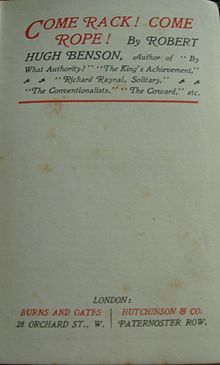St Edmund Campion grew to adulthood during the successive reigns, and successive religious revolutions, of the children of Henry VIII. After a brilliant academic career at Oxford, he was faced with the necessity of committing himself to one of these visions of the truth. Taking St Patrick as his patron, he chose to leave behind a promising career in the Church of England to serve Christ in the Society of Jesus. After a decade on the Continent - studying in Douai, being ordained in Rome, teaching and writing in Prague - he was ordered to return to England to minister to the Catholics living under persecution there. After a year he was betrayed and arrested, taken to the Tower of London for torture and trial. A series of semi-public disputations were held between Campion and Protestant scholars, and despite his being fresh from the rack and bereft of books it was generally conceded that he more than held his own. At his trial he further embarrassed Her Majesty's government by revealing that he had been offered a bishopric if he would join the established church, demonstrating that he was being persecuted for his religion and not for any alleged treason. As he was being drawn and quartered, a drop of his blood landed on the coat of the young lawyer Henry Walpole, who subsequently eulogized Campion in his poem "Why doe I use my paper, ynk and pen", immortalized in music by William Byrd:
Saynt Marie churche can tell, and all the scholes do know,
the walles may yet resound his praise, where he excelled soo
how scharpe yn science sound, how rype yn skyll was he?
how sweate for toung, how grave for trowthe, how deape for memoree?
how skyll yn antique writers, how rare yn everie arte, excelled.
And that wich most appearde, yet rarest for to fynde,
the more of learnyng he possest, more humble was hys mynde.
Kilroy's biography is thorough and impeccably researched, a scholarly biography of a scholarly man. Unfortunately, this also necessarily means that the book is a less than thrilling read, as the author carefully makes his way through the sources. Kilroy places Campion's mission to England in the context of the Sander expedition which sought to drive the English from Ireland with papal support, climaxing in Campion's arrest by troops mustered to defend England from Sander and his allies. Indeed, Kilroy uses Dr Sander as St Edmund's foil, as determined to restore Catholicism in Britain by military force as Campion was by the power of persuasion and the sacraments. Kilroy also briefly touches upon the immediate explosion of literature celebrating Campion and condemning the English government, published at underground presses in Britain and openly abroad, which establishes Campion's execution as a landmark in the increasing isolation of post-Reformation England from the culture of the Continent. Throughout, however, Kilroy keeps the focus on the person and personality of Edmund Campion, along the way proving the truth of Walpole's tribute, "the more of learnyng he possest, more humble was hys mynde."



